Assessing Climate and Land Use Change Impacts on Ecosystem Services in the Upper Minjiang River Basin
Abstract
1. Introduction
2. Materials and Methods
2.1. Study Area
2.2. Data Collection
- (1)
- Land use land cover (LULC) data: Land use land cover datasets with 30 m spatial resolution from 1990 to 2020 were obtained from Wuhan University. These LULC data were classified into cultivated land, forest, grassland, water body, construction land, and unused land following the classification system of the Chinese Academy of Sciences.
- (2)
- Digital elevation model (DEM): This DEM data with 30 m resolution were gathered from the Geospatial Data Cloud.
- (3)
- Meteorological data: Data on temperature, precipitation, and potential evapotranspiration with 1 km resolution from 1990 to 2020 were obtained from the National Tibet Plateau Data Center.
- (4)
- Soil data: Soil data with 1 km resolution were obtained from the World Soil Database through the National Qinghai–Tibet Plateau Data Center.
2.3. ESs Assessment and Mapping
2.3.1. Water Yield
2.3.2. Soil Conservation
2.3.3. Carbon Sequestration
2.3.4. Habitat Quality
2.4. Scenario Simulation Framework
- Scenario 1 (baseline scenario): 1990 land use and 1990 climate data,
- Scenario 2 (land use change effect only): 2000 land use data with 1990 climate data,
- Scenario 3 (climate change effect only): 1990 land use data with 2000 climate data,
- Scenario 4 (combined effects): 2000 land use data with 2000 climate data.
3. Results
3.1. Climatic Change
3.2. Temporal and Spatial Variations in LUC
3.3. ESs Dynamics
3.3.1. Changes in Water Yield Service
3.3.2. Changes in Soil Conservation Service
3.3.3. Changes in Carbon Sequestration Service
3.3.4. Changes in Habitat Quality Service
3.4. ESs Dynamics Under Different Simulation Scenarios from 1990–2020
3.5. ESs Dynamics Under Different Simulation Scenarios in 2050
3.6. The Independent Contributions of Climate Change and LUC to ES Dynamics
4. Discussion
5. Conclusions
Author Contributions
Funding
Data Availability Statement
Acknowledgments
Conflicts of Interest
References
- Malhi, Y.; Franklin, J.; Seddon, N.; Solan, M.; Turner, M.G.; Field, C.B.; Knowlton, N. Climate change and ecosystems: Threats, opportunities and solutions. R. Soc. 2020, 375, 20190104. [Google Scholar] [CrossRef] [PubMed]
- Lawler, J.J.; Lewis, D.J.; Nelson, E.; Plantinga, A.J.; Polasky, S.; Withey, J.C.; Helmers, D.P.; Martinuzzi, S.; Pennington, D.; Radeloff, V.C. Projected land-use change impacts on ecosystem services in the United States. Proc. Natl. Acad. Sci. USA 2014, 111, 7492–7497. [Google Scholar] [CrossRef] [PubMed]
- Hasan, S.S.; Zhen, L.; Miah, M.G.; Ahamed, T.; Samie, A. Impact of land use change on ecosystem services: A review. Environ. Dev. 2020, 34, 100527. [Google Scholar] [CrossRef]
- Ostrom, E. A general framework for analyzing sustainability of social-ecological systems. Science 2009, 325, 419–422. [Google Scholar] [CrossRef] [PubMed]
- Díaz, S.; Pascual, U.; Stenseke, M.; Martín-López, B.; Watson, R.T.; Molnár, Z.; Hill, R.; Chan, K.M.; Baste, I.A.; Brauman, K.A. Assessing nature’s contributions to people. Science 2018, 359, 270–272. [Google Scholar] [CrossRef]
- Costanza, R.; d’Arge, R.; De Groot, R.; Farber, S.; Grasso, M.; Hannon, B.; Limburg, K.; Naeem, S.; O’neill, R.V.; Paruelo, J. The value of the world’s ecosystem services and natural capital. Nature 1997, 387, 253–260. [Google Scholar] [CrossRef]
- Wood, S.L.; Jones, S.K.; Johnson, J.A.; Brauman, K.A.; Chaplin-Kramer, R.; Fremier, A.; Girvetz, E.; Gordon, L.J.; Kappel, C.V.; Mandle, L. Distilling the role of ecosystem services in the Sustainable Development Goals. Ecosyst. Serv. 2018, 29, 70–82. [Google Scholar] [CrossRef]
- Costanza, R.; De Groot, R.; Sutton, P.; Van der Ploeg, S.; Anderson, S.J.; Kubiszewski, I.; Farber, S.; Turner, R.K. Changes in the global value of ecosystem services. Glob. Environ. Change 2014, 26, 152–158. [Google Scholar] [CrossRef]
- Zhang, G.; Zheng, D.; Xie, L.; Zhang, X.; Wu, H.; Li, S. Mapping changes in the value of ecosystem services in the Yangtze River Middle Reaches Megalopolis, China. Ecosyst. Serv. 2021, 48, 101252. [Google Scholar] [CrossRef]
- Srivathsa, A.; Vasudev, D.; Nair, T.; Chakrabarti, S.; Chanchani, P.; DeFries, R.; Deomurari, A.; Dutta, S.; Ghose, D.; Goswami, V.R. Prioritizing India’s landscapes for biodiversity, ecosystem services and human well-being. Nat. Sustain. 2023, 6, 568–577. [Google Scholar] [CrossRef]
- Schirpke, U.; Ghermandi, A.; Sinclair, M.; Van Berkel, D.; Fox, N.; Vargas, L.; Willemen, L. Emerging technologies for assessing ecosystem services: A synthesis of opportunities and challenges. Ecosyst. Serv. 2023, 63, 101558. [Google Scholar] [CrossRef]
- Sharp, R.; Douglass, J.; Wolny, S.; Arkema, K.; Bernhardt, J.; Bierbower, W.; Chaumont, N.; Denu, D.; Fisher, D.; Glowinski, K. InVEST 3.8.7. User’s Guide; The Natural Capital Project, Standford University, University of Minnesota, The Nature Conservancy, and World Wildlife Fund: Standford, CA, USA, 2020; pp. 20–40. [Google Scholar]
- Bagstad, K.J.; Semmens, D.J.; Waage, S.; Winthrop, R. A comparative assessment of decision-support tools for ecosystem services quantification and valuation. Ecosyst. Serv. 2013, 5, 27–39. [Google Scholar] [CrossRef]
- Díaz, S.M.; Settele, J.; Brondízio, E.; Ngo, H.; Guèze, M.; Agard, J.; Arneth, A.; Balvanera, P.; Brauman, K.; Butchart, S. The Global Assessment Report on Biodiversity and Ecosystem Services: Summary for Policy Makers; IPBES: Bon, Germany, 2019. [Google Scholar]
- Mendoza-Ponce, A.; Corona-Núñez, R.; Kraxner, F.; Leduc, S.; Patrizio, P. Identifying effects of land use cover changes and climate change on terrestrial ecosystems and carbon stocks in Mexico. Glob. Environ. Change 2018, 53, 12–23. [Google Scholar] [CrossRef]
- Foley, J.A.; DeFries, R.; Asner, G.P.; Barford, C.; Bonan, G.; Carpenter, S.R.; Chapin, F.S.; Coe, M.T.; Daily, G.C.; Gibbs, H.K. Global consequences of land use. Science 2005, 309, 570–574. [Google Scholar] [CrossRef]
- Su, C.; Fu, B. Evolution of ecosystem services in the Chinese Loess Plateau under climatic and land use changes. Glob. Planet. Change 2013, 101, 119–128. [Google Scholar] [CrossRef]
- Hicke, J.A.; Lobell, D.B.; Asner, G.P. Cropland area and net primary production computed from 30 years of USDA agricultural harvest data. Earth Interact. 2004, 8, 1–20. [Google Scholar] [CrossRef]
- Meersmans, J.; Arrouays, D.; Van Rompaey, A.J.; Pagé, C.; De Baets, S.; Quine, T.A. Future C loss in mid-latitude mineral soils: Climate change exceeds land use mitigation potential in France. Sci. Rep. 2016, 6, 35798. [Google Scholar] [CrossRef] [PubMed]
- Li, Y.; Luo, H. Trade-off/synergistic changes in ecosystem services and geographical detection of its driving factors in typical karst areas in southern China. Ecol. Indic. 2023, 154, 110811. [Google Scholar] [CrossRef]
- Ma, S.; Li, Y.; Zhang, Y.; Wang, L.-J.; Jiang, J.; Zhang, J. Distinguishing the relative contributions of climate and land use/cover changes to ecosystem services from a geospatial perspective. Ecol. Indic. 2022, 136, 108645. [Google Scholar] [CrossRef]
- Xiao, J.; Song, F.; Su, F.; Shi, Z.; Song, S. Quantifying the independent contributions of climate and land use change to ecosystem services. Ecol. Indic. 2023, 153, 110411. [Google Scholar] [CrossRef]
- Zhang, Y.; Wu, T.; Song, C.; Hein, L.; Shi, F.; Han, M.; Ouyang, Z. Influences of climate change and land use change on the interactions of ecosystem services in China’s Xijiang River Basin. Ecosyst. Serv. 2022, 58, 101489. [Google Scholar] [CrossRef]
- Sunl, Y.; Sun, M. Coupled impacts of climate and land use changes on regional ecosystem services. J. Environ. Manag. 2023, 326, 116753. [Google Scholar]
- Seidl, R.; Albrich, K.; Erb, K.; Formayer, H.; Leidinger, D.; Leitinger, G.; Tappeiner, U.; Tasser, E.; Rammer, W. What drives the future supply of regulating ecosystem services in a mountain forest landscape? Forest Ecol. Manag. 2019, 445, 37–47. [Google Scholar] [CrossRef] [PubMed]
- Payne, D.; Spehn, E.M.; Snethlage, M.; Fischer, M. Opportunities for research on mountain biodiversity under global change. Curr. Opin. Environ. Sustain. 2017, 29, 40–47. [Google Scholar] [CrossRef]
- Liu, Y.; Li, J.; Yang, Y. Strategic adjustment of land use policy under the economic transformation. Land Use Policy 2018, 74, 5–14. [Google Scholar] [CrossRef]
- Yuan, Z.; Liang, Y.; Zhao, H.; Wei, D.; Wang, X. Trade-offs and synergies between ecosystem services on the Tibetan Plateau. Ecol. Indic. 2024, 158, 111384. [Google Scholar] [CrossRef]
- Luo, D.; Gao, Z.; Chen, F.; Wang, L.; Liu, J.; Li, S.; Shen, Q.; Zao, Y. Revised understanding of permafrost shape: Inclusion of the transition zone and its climatic and environmental significances. J. Earth Sci. 2025, 36, 339–349. [Google Scholar] [CrossRef]
- Zhang, J.; Sun, J.; Ma, B.; Du, W. Assessing the ecological vulnerability of the upper reaches of the Minjiang River. PLoS ONE 2017, 12, e0181825. [Google Scholar] [CrossRef]
- Liu, Y.; Wang, L.; Zou, Q.; Li, J.; Lu, Y.; Li, L.; Xu, B.; Wang, L. Post-disaster spatial reconstruction from the perspective of a rural settlement niche in the upper reaches of the Minjiang River. J. Mt. Sci. 2024, 21, 1630–1646. [Google Scholar] [CrossRef]
- Liu, M.; Hu, Y.; Chang, Y.; He, X.; Zhang, W. Land use and land cover change analysis and prediction in the upper reaches of the Minjiang River, China. Environ. Manag. 2009, 43, 899–907. [Google Scholar] [CrossRef]
- Li, A.; Wang, A.; Liang, S.; Zhou, W. Eco-environmental vulnerability evaluation in mountainous region using remote sensing and GIS—A case study in the upper reaches of Minjiang River, China. Ecol. Model. 2006, 192, 175–187. [Google Scholar] [CrossRef]
- Hou, J.; Ye, A.; You, J.; Ma, F.; Duan, Q. An estimate of human and natural contributions to changes in water resources in the upper reaches of the Minjiang River. Sci. Total Environ. 2018, 635, 901–912. [Google Scholar] [CrossRef] [PubMed]
- Fu, B.; Stafford-Smith, M.; Wang, Y.; Wu, B.; Yu, X.; Lv, N.; Ojima, D.S.; Lv, Y.; Fu, C.; Liu, Y.; et al. The Global-DEP conceptual framework—Research on dryland ecosystems to promote sustainability. Curr. Opin. Environ. Sustain. 2021, 48, 17–28. [Google Scholar] [CrossRef]
- Tang, Q.; He, X.; Bao, Y.; Zhang, X.; Guo, F.; Zhu, H. Determining the relative contributions of climate change and multiple human activities to variations of sediment regime in the Minjiang River, China. Hydrol. Process. 2013, 27, 3547–3559. [Google Scholar] [CrossRef]
- Millennium Ecosystem Assessment. Ecosystems and Human Well-Being: Synthesis; Island Press: Washington, DC, USA, 2005. [Google Scholar]
- Duan, L.; Yang, S.; Xiang, M.; Li, W.; Li, J. Spatiotemporal evolution and driving factors of ecosystem service value in the Upper Minjiang River of China. Sci. Rep. 2024, 14, 23398. [Google Scholar] [CrossRef]
- Zhang, W.; Hu, Y.; Zhang, J.; Liu, M.; Yang, Z. Assessment of land use change and potential eco-service value in the upper reaches of Minjiang River, China. J. For. Res. 2007, 18, 97–102. [Google Scholar] [CrossRef]
- Feng, X.; Sun, G.; Fu, B.; Su, C.; Liu, Y.; Lamparski, H. Regional effects of vegetation restoration on water yield across the Loess Plateau, China. Hydrol. Earth Syst. Sci. 2012, 16, 2617–2628. [Google Scholar] [CrossRef]
- Lang, Y.; Song, W.; Zhang, Y. Responses of the water-yield ecosystem service to climate and land use change in Sancha River Basin, China. Phys. Chem. Earth. 2017, 101, 102–111. [Google Scholar] [CrossRef]
- Yang, D.; Liu, W.; Tang, L.; Chen, L.; Li, X.; Xu, X. Estimation of water provision service for monsoon catchments of South China: Applicability of the InVEST model. Landsc. Urban Plan. 2019, 182, 133–143. [Google Scholar] [CrossRef]
- Xiao, Q.; Hu, D.; Xiao, Y. Assessing changes in soil conservation ecosystem services and causal factors in the Three Gorges Reservoir region of China. J. Clean. Prod. 2017, 163, S172–S180. [Google Scholar] [CrossRef]
- Zhang, K.; Shu, A.; Xu, X.; Yang, Q.; Yu, B. Soil erodibility and its estimation for agricultural soils in China. J. Arid Environ. 2008, 72, 1002–1011. [Google Scholar] [CrossRef]
- Jones, C.; Dyke, P.; Williams, J.; Kiniry, J.; Benson, V.; Griggs, R. EPIC: An operational model for evaluation of agricultural sustainability. Agric. Syst. 1991, 37, 341–350. [Google Scholar] [CrossRef]
- Renard, K.G. Predicting Soil Erosion by Water: A Guide to Conservation Planning with the Revised Universal Soil Loss Equation (RUSLE); US Department of Agriculture, Agricultural Research Service: Beltsville, MD, USA, 1997.
- Falkowski, P.; Scholes, R.J.; Boyle, E.; Canadell, J.; Canfield, D.; Elser, J.; Gruber, N.; Hibbard, K.; Högberg, P.; Linder, S. The global carbon cycle: A test of our knowledge of earth as a system. Science 2000, 290, 291–296. [Google Scholar] [CrossRef] [PubMed]
- Peng, Y.; Yang, W.; Li, J.; Wang, B.; Zhang, C.; Yue, K.; Wu, F. Contribution of soil fauna to foliar litter-mass loss in winter in an ecotone between dry valley and montane forest in the upper reaches of the Minjiang River. PLoS ONE 2015, 10, e0124605. [Google Scholar] [CrossRef] [PubMed]
- Yang, Z.S. Investigation and Study of Wild Vegetable Resources of the Upper Reach of the Minjiang River. Adv. Mater. 2014, 864, 2474–2477. [Google Scholar] [CrossRef]
- Tang, F.; Fu, M.; Wang, L.; Zhang, P. Land-use change in Changli County, China: Predicting its spatio-temporal evolution in habitat quality. Ecol. Indic. 2020, 117, 106719. [Google Scholar] [CrossRef]
- Song, Y.; Wang, M.; Sun, X.; Fan, Z. Quantitative assessment of the habitat quality dynamics in Yellow River Basin, China. Environ. Monit. Assess. 2021, 193, 614. [Google Scholar] [CrossRef]
- Ferreira, P.; van Soesbergen, A.; Mulligan, M.; Freitas, M.; Vale, M.M. Can forests buffer negative impacts of land-use and climate changes on water ecosystem services? The case of a Brazilian megalopolis. Sci. Total Environ. 2019, 685, 248–258. [Google Scholar] [CrossRef]
- Wang, X.; Wu, J.; Liu, Y.; Hai, X.; Shanguan, Z.; Deng, L. Driving factors of ecosystem services and their spatiotemporal change assessment based on land use types in the Loess Plateau. J. Environ. Manag. 2022, 311, 114835. [Google Scholar] [CrossRef]
- Lei, J.; Wang, S.; Wu, J.; Wang, J.; Xiong, X. Land-use configuration has significant impacts on water-related ecosystem services. Ecol. Eng. 2021, 160, 106133. [Google Scholar] [CrossRef]
- Wu, Y.; Zhang, X.; Li, C.; Xu, Y.; Hao, F.; Yin, G. Ecosystem service trade-offs and synergies under influence of climate and land cover change in an afforested semiarid basin, China. Ecol. Eng. 2021, 159, 106083. [Google Scholar] [CrossRef]
- Wang, H.; Zhou, S.; Li, X.; Liu, H.; Chi, D.; Xu, K. The influence of climate change and human activities on ecosystem service value. Ecol. Eng. 2016, 87, 224–239. [Google Scholar] [CrossRef]
- Clerici, N.; Cote-Navarro, F.; Escobedo, F.J.; Rubiano, K.; Villegas, J.C. Spatio-temporal and cumulative effects of land use-land cover and climate change on two ecosystem services in the Colombian Andes. Sci. Total Environ. 2019, 685, 1181–1192. [Google Scholar] [CrossRef]
- Ciftcioglu, G.C. Revealing major terrestrial-and marine species-based provisioning ecosystem services provided by the socio-ecological production landscapes and seascapes of Lefke Region in North Cyprus. Environ. Dev. Sustain. 2018, 20, 197–221. [Google Scholar] [CrossRef]
- Khalifa, M.; Elagib, N.A.; Ribbe, L.; Schneider, K. Spatio-temporal variations in climate, primary productivity and efficiency of water and carbon use of the land cover types in Sudan and Ethiopia. Sci. Total Environ. 2018, 624, 790–806. [Google Scholar] [CrossRef]
- Salimi, S.; Almuktar, S.A.; Scholz, M. Impact of climate change on wetland ecosystems: A critical review of experimental wetlands. J. Environ. Manag. 2021, 286, 112160. [Google Scholar] [CrossRef]
- Dai, E.; Yin, L.; Wang, Y.; Ma, L.; Tong, M. Quantitative assessment of the relative impacts of land use and climate change on the key ecosystem services in the Hengduan Mountain Region, China. Sustainability 2020, 12, 4100. [Google Scholar] [CrossRef]
- Gomes, L.C.; Bianchi, F.J.; Cardoso, I.M.; Fernandes Filho, E.I.; Schulte, R.P. Land use change drives the spatio-temporal variation of ecosystem services and their interactions along an altitudinal gradient in Brazil. Landsc. Ecol. 2020, 35, 1571–1586. [Google Scholar] [CrossRef]
- Gao, J.; Bian, H.; Zhu, C.; Tang, S. The response of key ecosystem services to land use and climate change in Chongqing: Time, space, and altitude. J. Geogr. Sci. 2022, 32, 317–332. [Google Scholar] [CrossRef]
- Ma, X.; Zhang, P.; Yang, L.; Qi, Y.; Liu, J.; Liu, L.; Fan, X.; Hou, K. Assessing the relative contributions, combined effects and multiscale uncertainty of future land use and climate change on water-related ecosystem services in Southwest China using a novel integrated modelling framework. Sustain. Cities Soc. 2024, 106, 105400. [Google Scholar] [CrossRef]
- Liu, X.; Pei, F.; Wen, Y.; Li, X.; Wang, S.; Wu, C.; Cai, Y.; Wu, J.; Chen, J.; Feng, K. Global urban expansion offsets climate-driven increases in terrestrial net primary productivity. Nat. Commun. 2019, 10, 5558. [Google Scholar] [CrossRef] [PubMed]
- Naudiyal, N.; Wang, J.; Ning, W.; Gaire, N.P.; Peili, S.; Yanqiang, W.; Jiali, H.; Ning, S. Potential distribution of Abies, Picea, and Juniperus species in the sub-alpine forest of Minjiang headwater region under current and future climate scenarios and its implications on ecosystem services supply. Ecol. Indic. 2021, 121, 107131. [Google Scholar] [CrossRef]
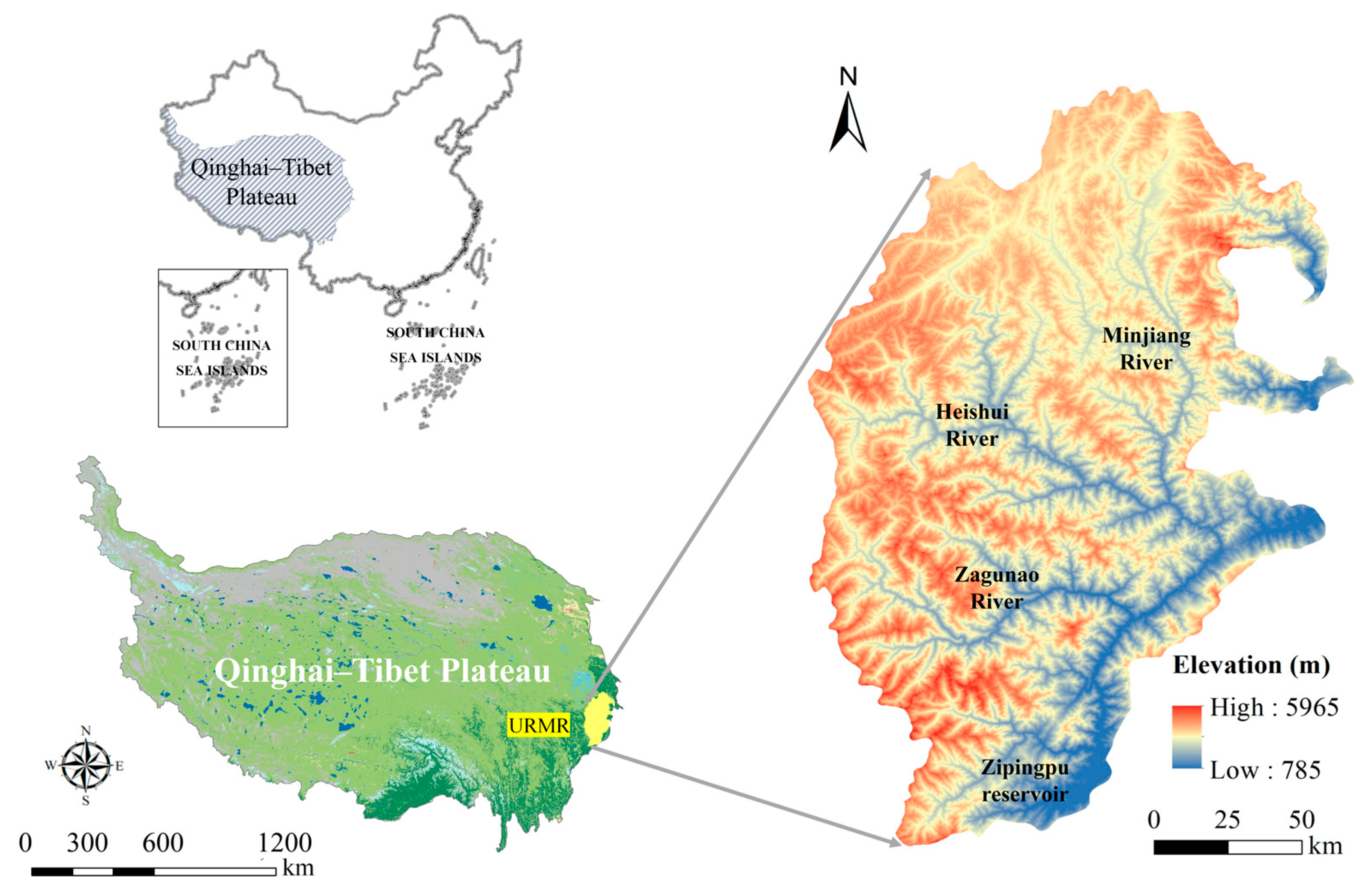
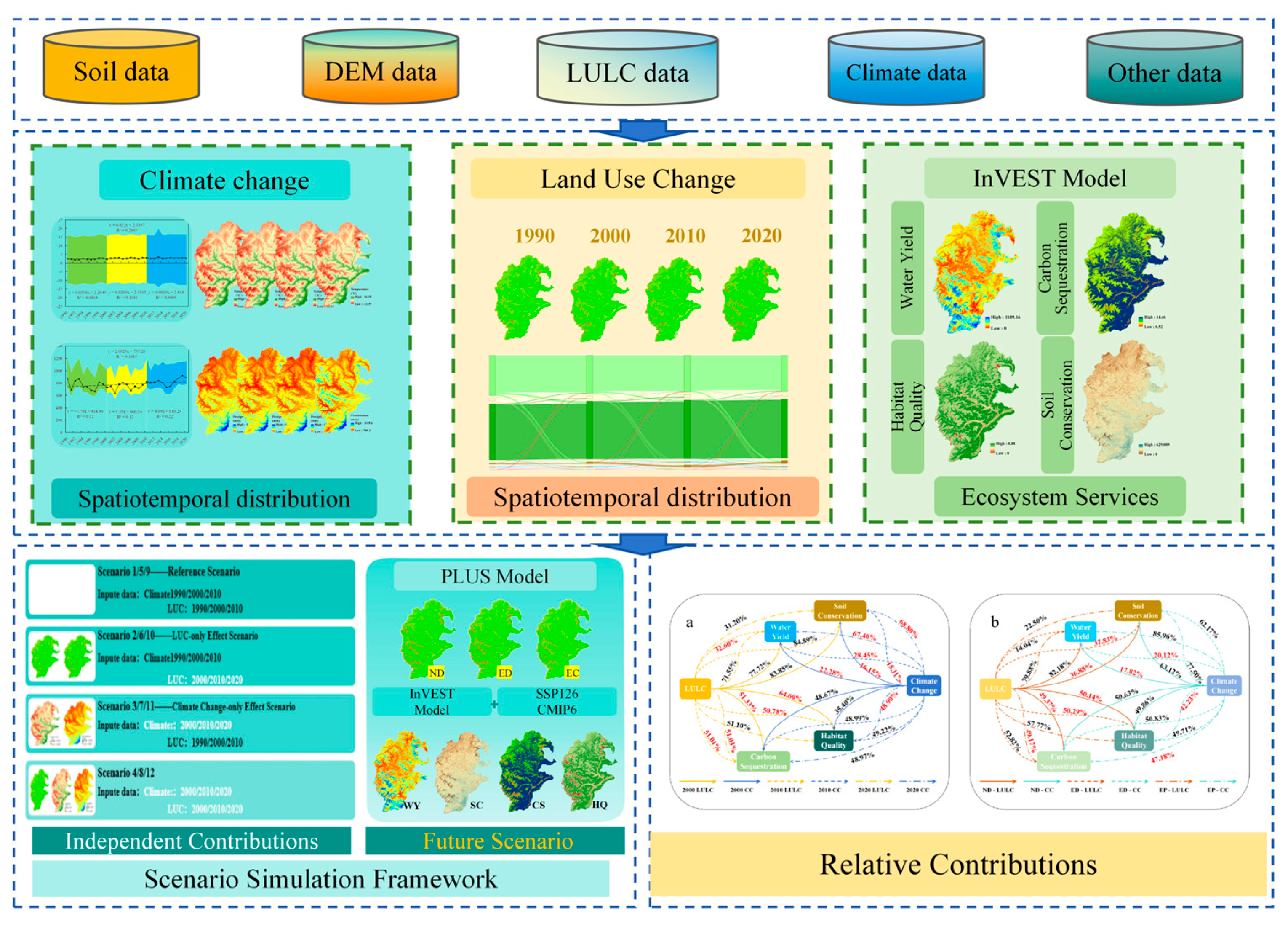
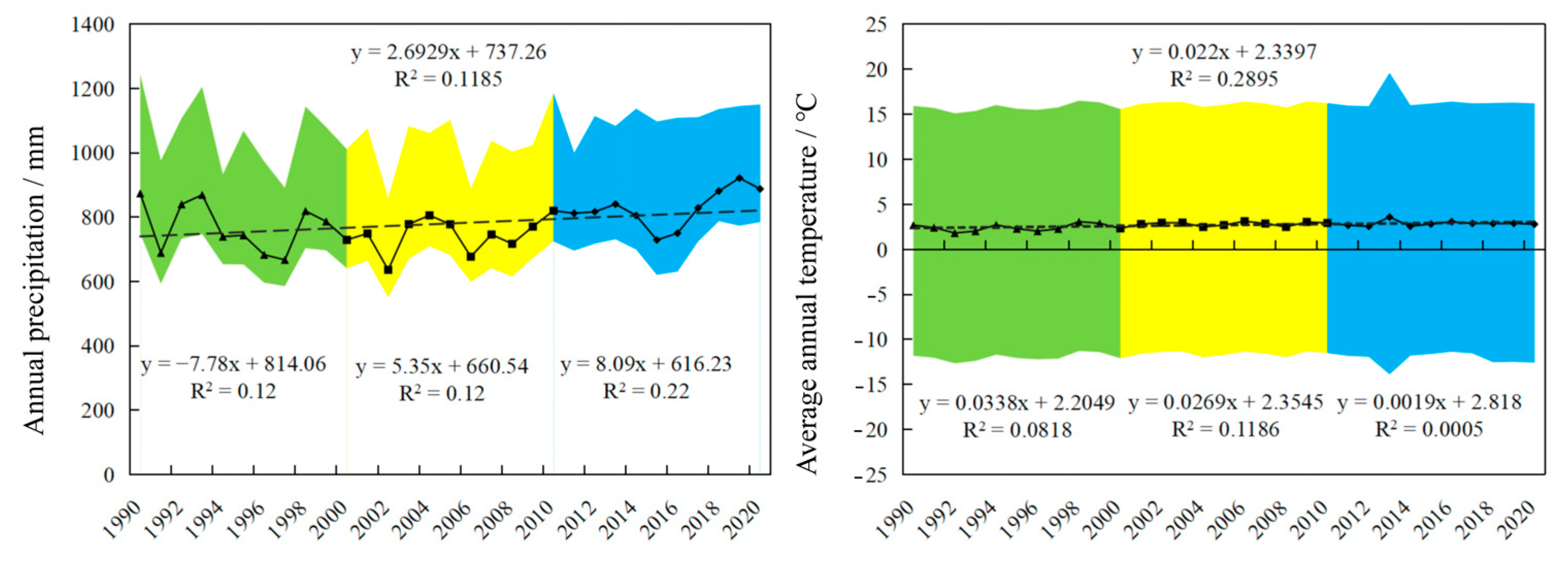
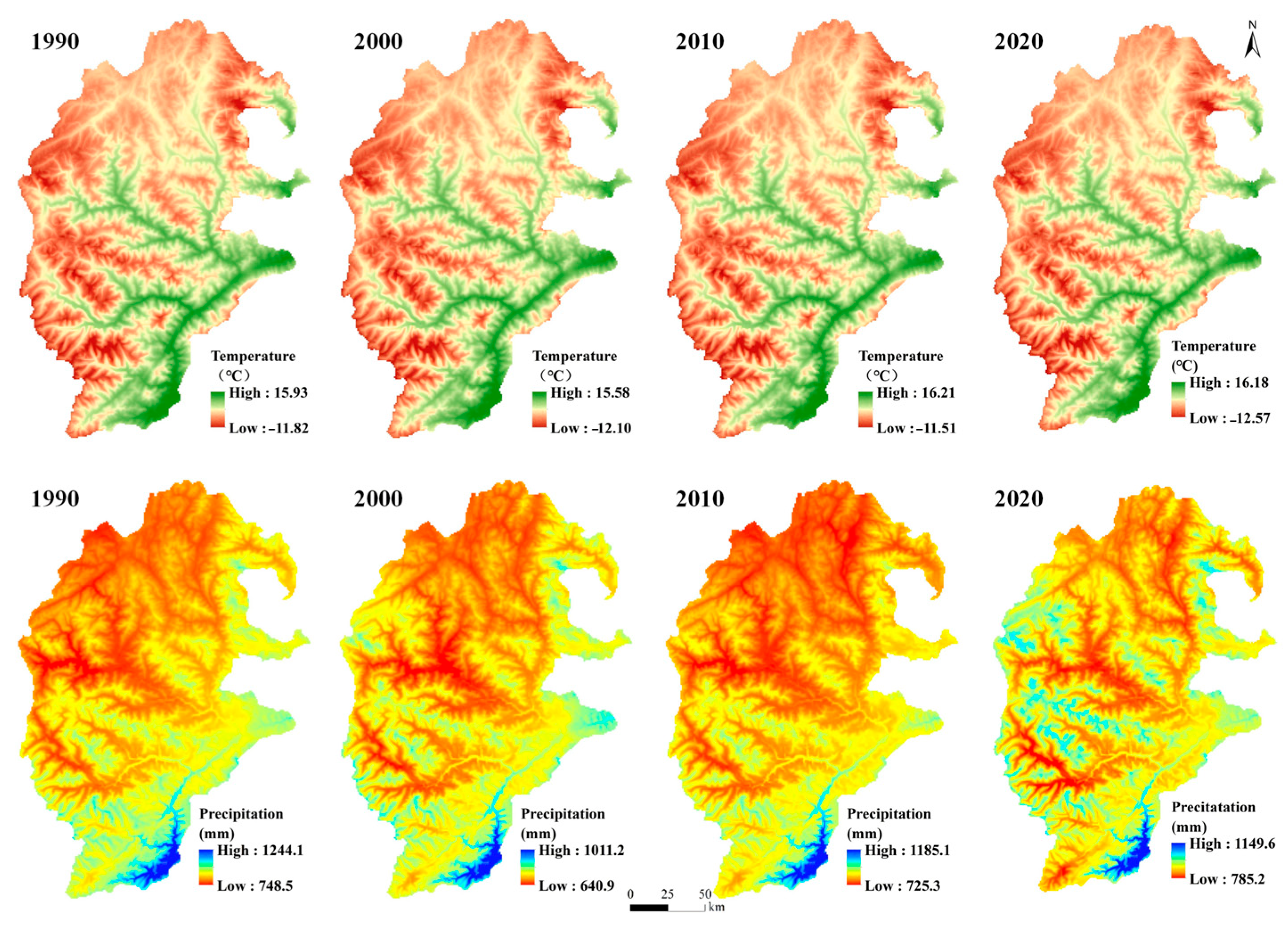
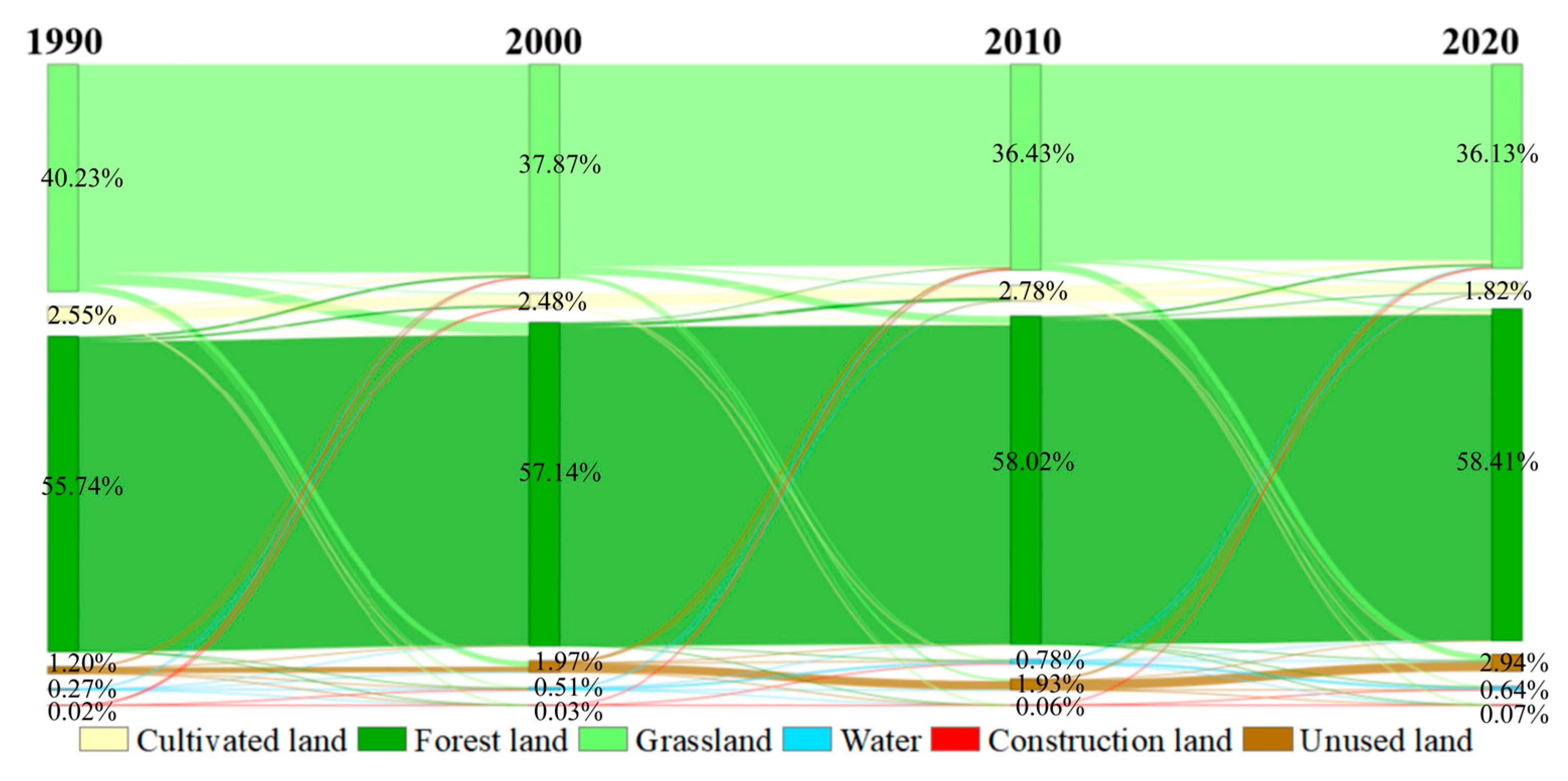
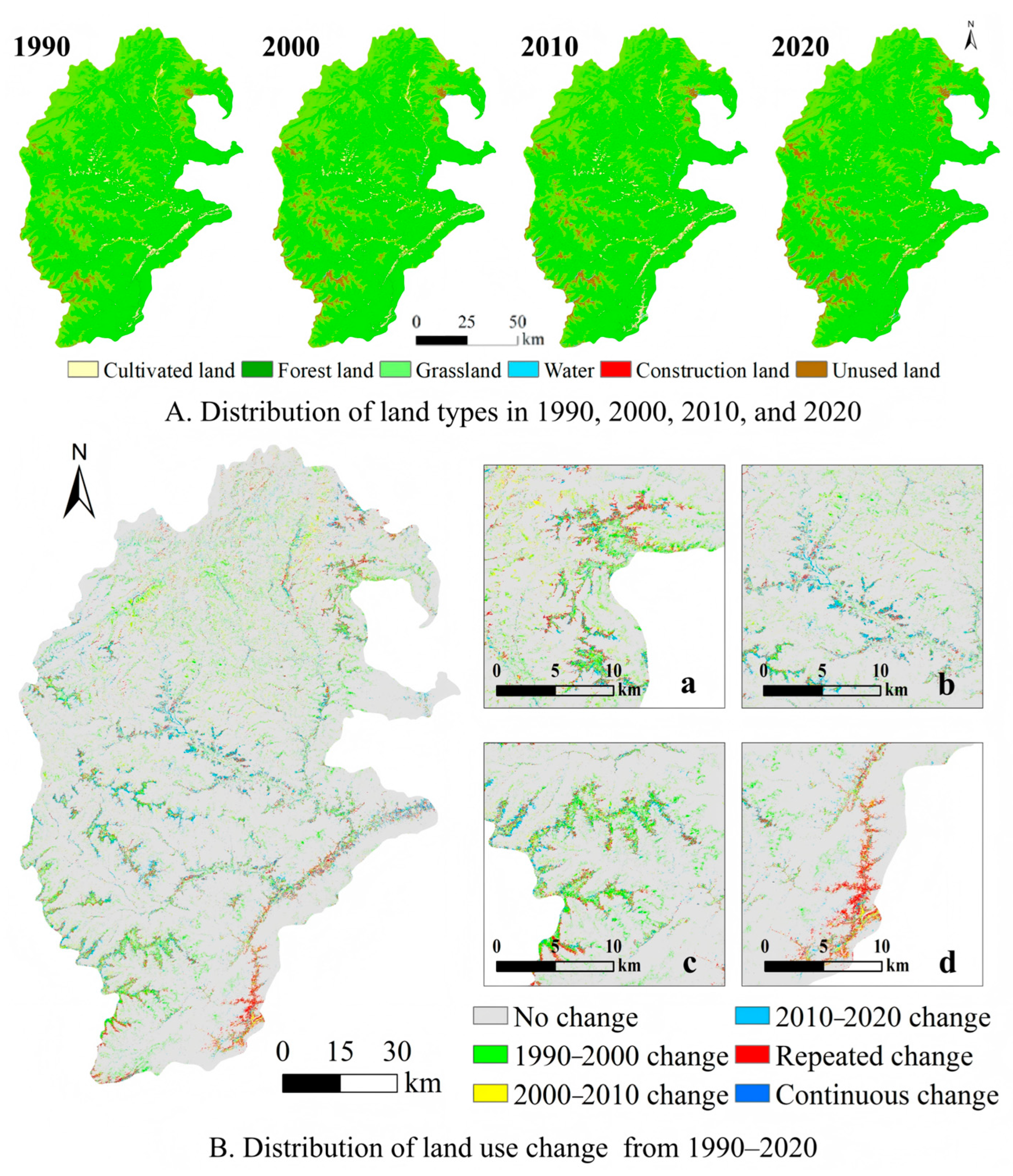
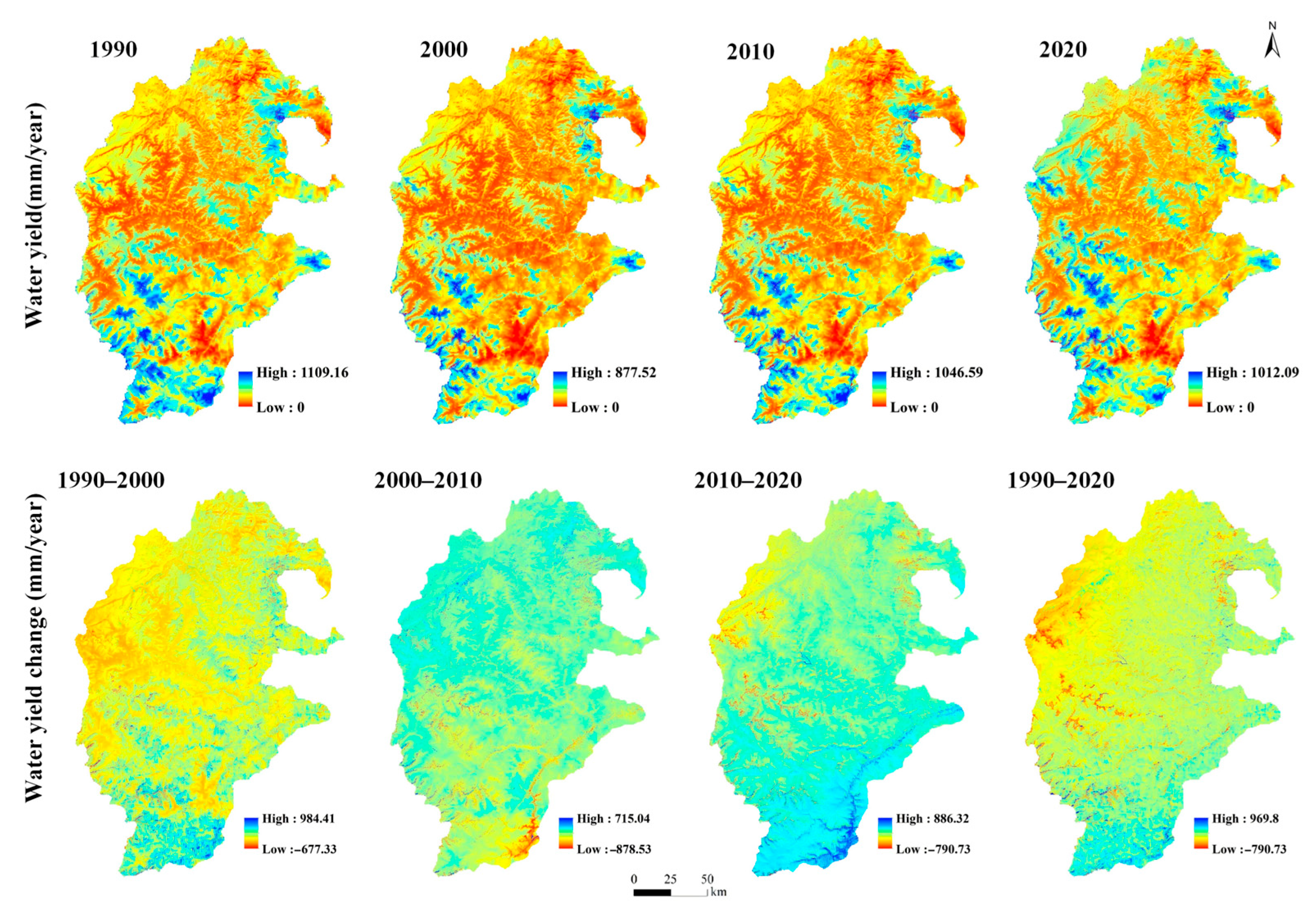

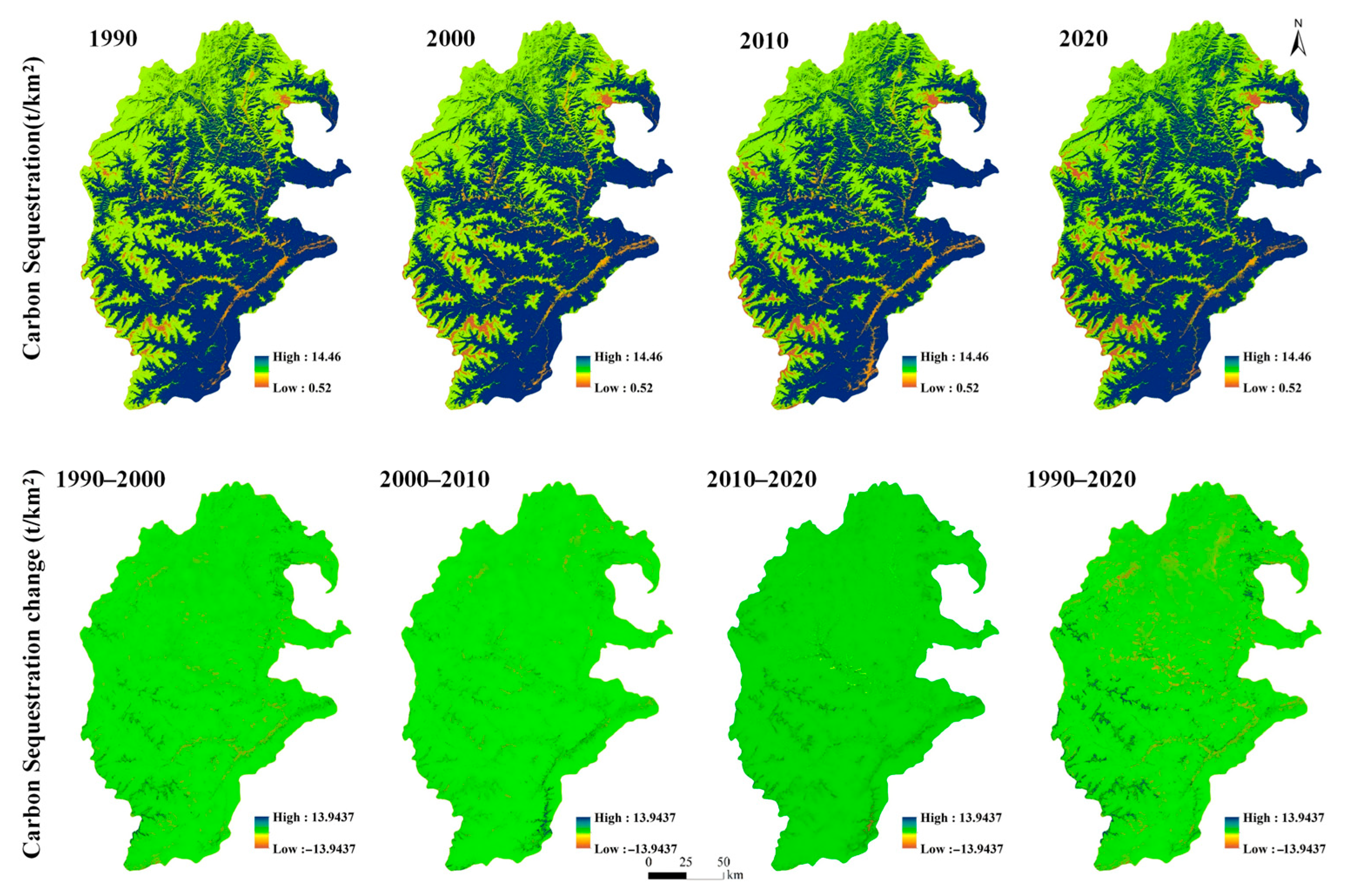
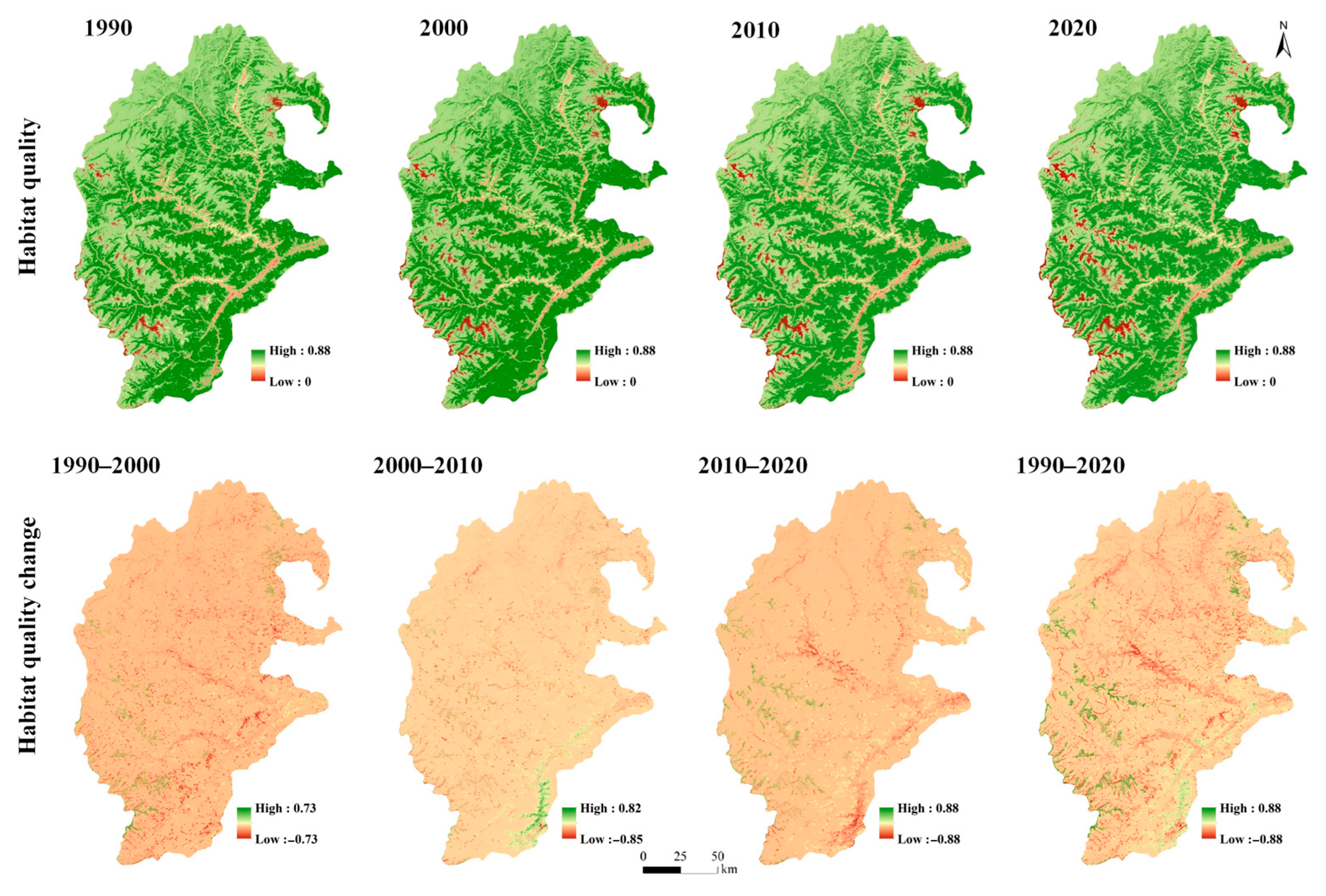
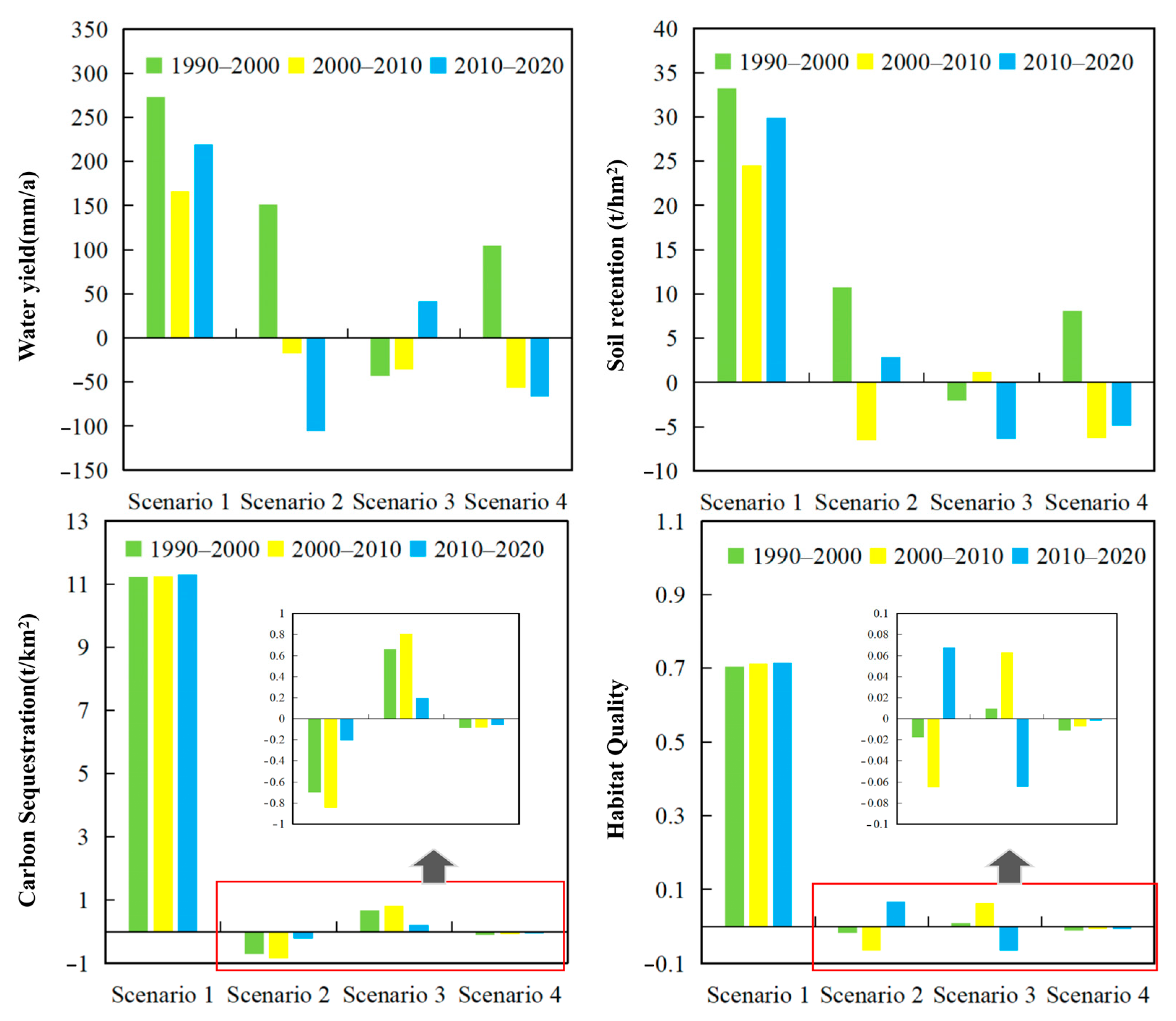
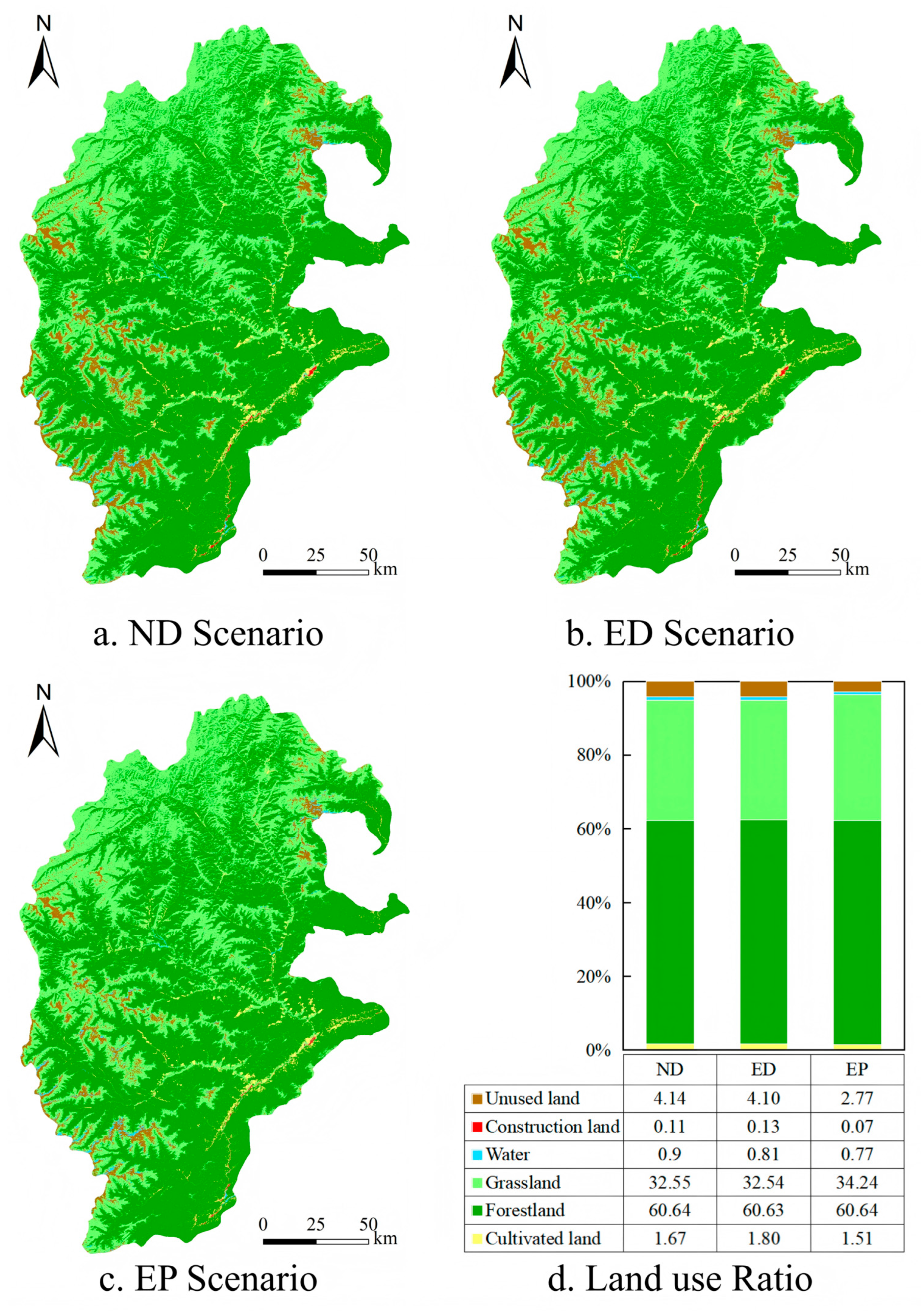

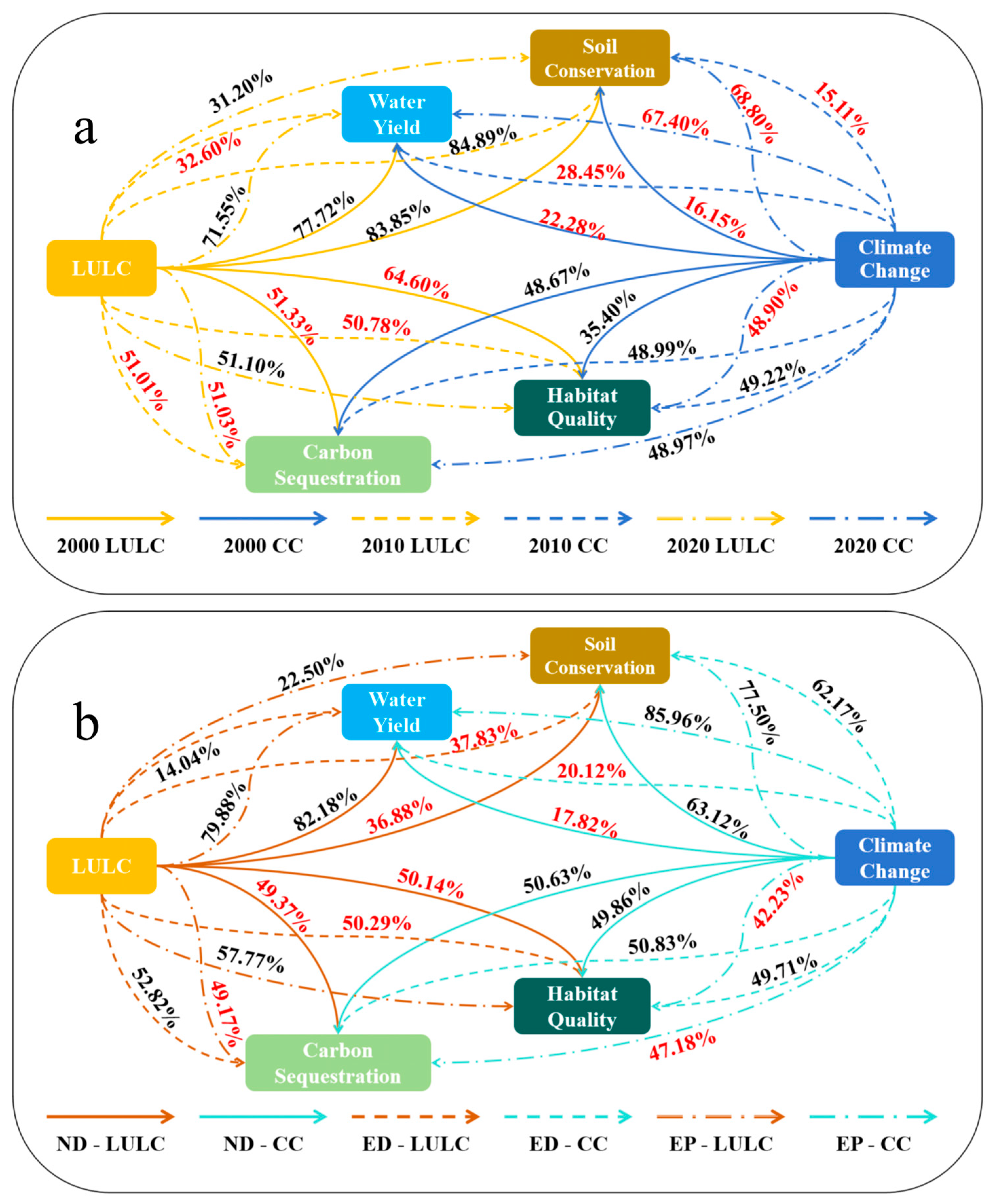
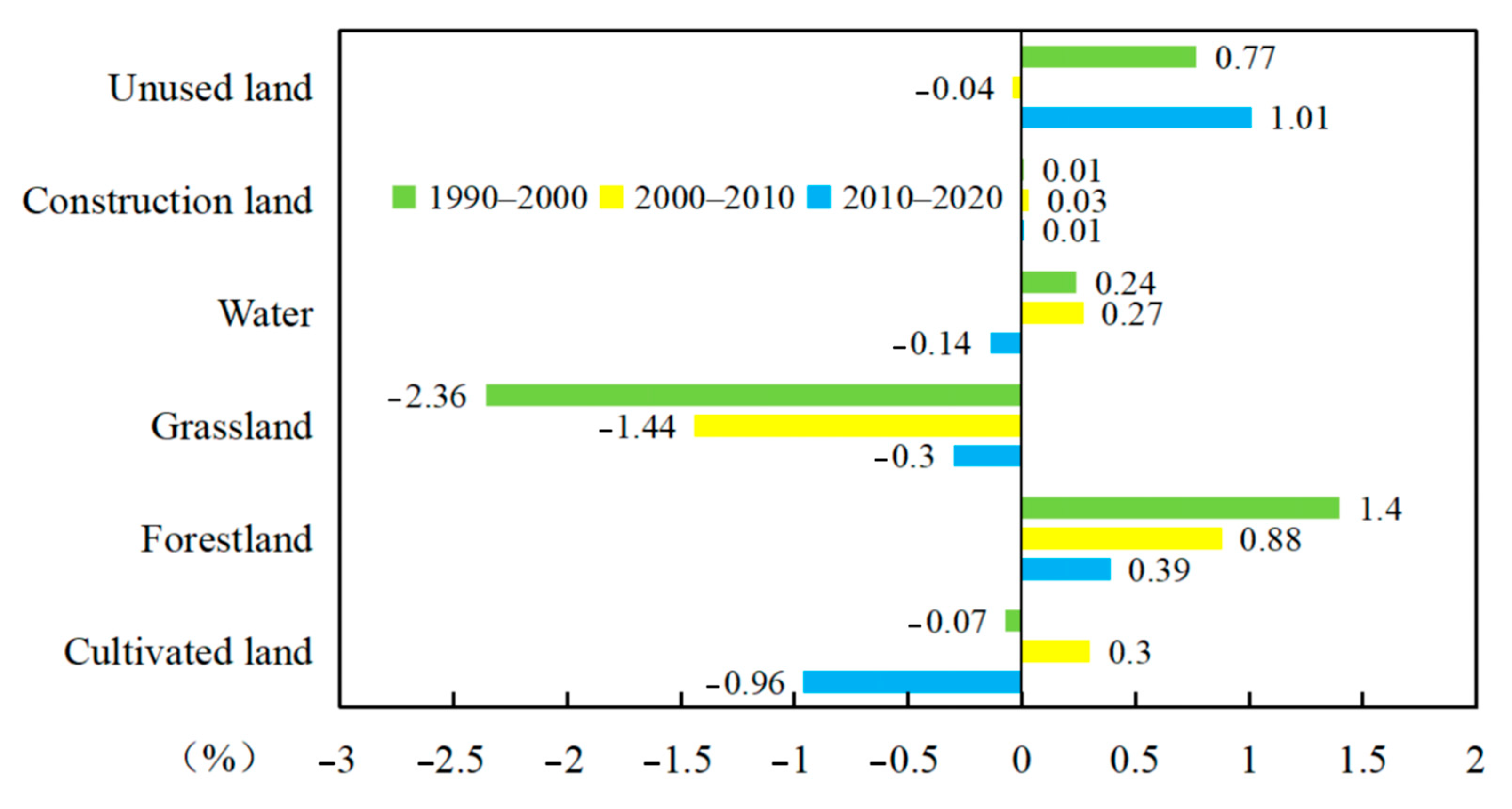
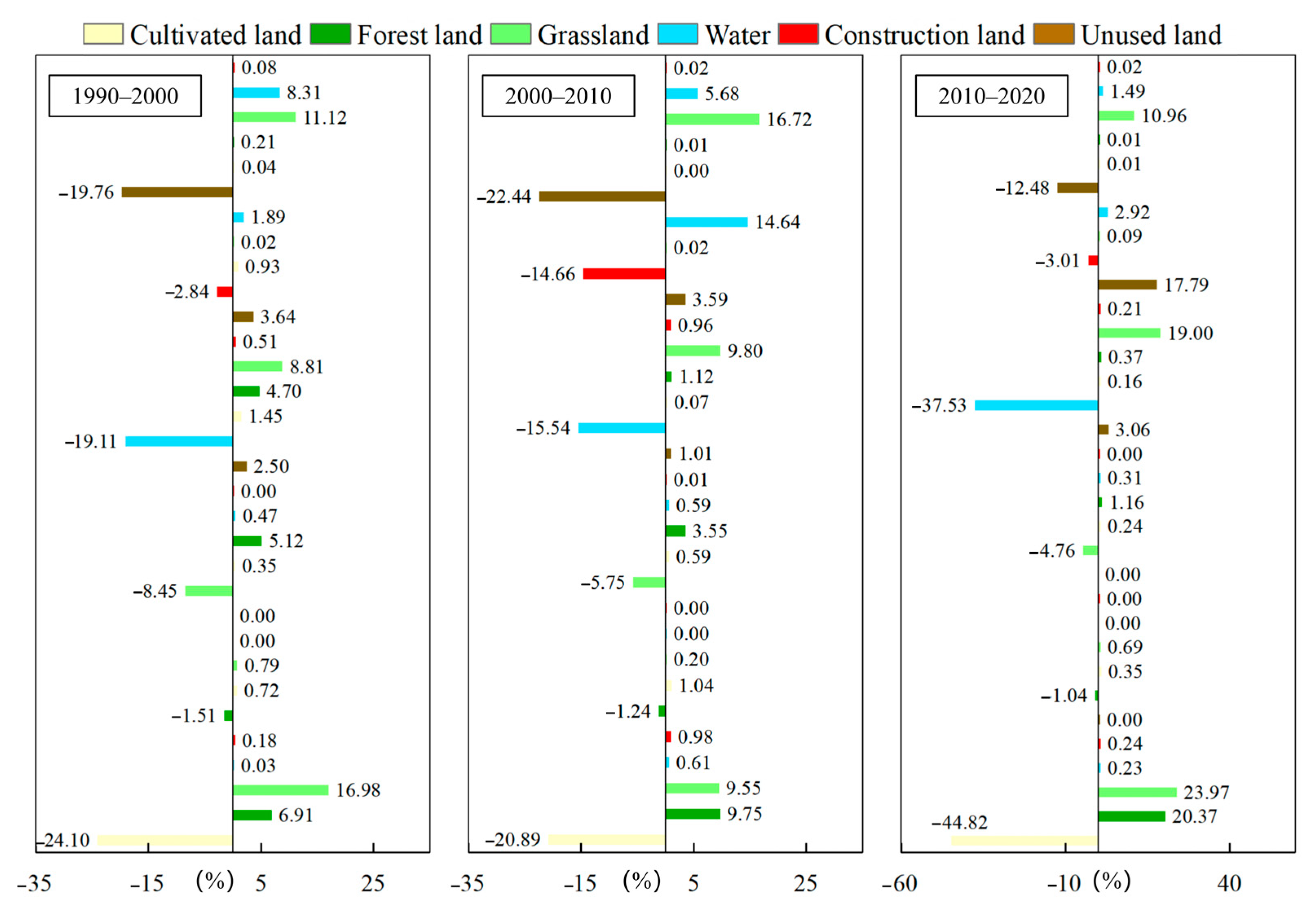
| Data | Data Type/Resolution | Source | Website |
|---|---|---|---|
| Land use/land cover | Raster data/30 m | National Earth System Science Data Center | https://www.resdc.cn/ |
| Digital elevation model (DEM) | Raster data/30 m | National Earth System Science Data Center | https://www.resdc.cn/ |
| Temperature | Raster data/1000 m | The National Tibetan Plateau Data Center | https://data.tpdc.ac.cn/ |
| Precipitation | Raster data/1000 m | The National Tibetan Plateau Data Center | https://data.tpdc.ac.cn/ |
| Potential evapotranspiration | Raster data/1000 m | The National Tibetan Plateau Data Center | https://data.tpdc.ac.cn/ |
| Soil data | Raster data/1000 m | Harmonized World Soil Database | https://www.fao.org/ |
| 1990–2000 | Scenario 1 | Scenario 2 | Scenario 3 | Scenario 4 | |
| Input | Climate | 1990 | 1990 | 2000 | 2000 |
| LULC | 1990 | 2000 | 1990 | 2000 | |
| Output | Re1 | ESlucc1 | EScli1 | ES1 | |
| 2000–2010 | Scenario 1 | Scenario 2 | Scenario 3 | Scenario 4 | |
| Input | Climate | 2000 | 2000 | 2010 | 2010 |
| LULC | 2000 | 2010 | 2000 | 2010 | |
| Output | Re2 | ESlucc2 | EScli2 | ES2 | |
| 2010–2020 | Scenario 1 | Scenario 2 | Scenario 3 | Scenario 4 | |
| Input | Climate | 2010 | 2010 | 2020 | 2020 |
| LULC | 2010 | 2020 | 2010 | 2020 | |
| Output | Re3 | ESlucc3 | EScli3 | ES3 | |
| 1990 | 2000 | 2010 | 2020 | |||||
|---|---|---|---|---|---|---|---|---|
| Area/km2 | Ratio (%) | Area/km2 | Ratio (%) | Area/km2 | Ratio (%) | Area/km2 | Ratio (%) | |
| Cultivated land | 744.47 | 2.55 | 725.56 | 2.48 | 811.55 | 2.78 | 532.2 | 1.82 |
| Forestland | 16,291.17 | 55.74 | 16,700.26 | 57.14 | 16,959.88 | 58.02 | 17,071.87 | 58.41 |
| Grassland | 11,758.12 | 40.23 | 11,069.27 | 37.87 | 10,647.58 | 36.43 | 10,560.18 | 36.13 |
| Water | 78.87 | 0.27 | 148.51 | 0.51 | 228.68 | 0.78 | 185.94 | 0.64 |
| Construction land | 350.16 | 0.02 | 576.92 | 0.03 | 564.2 | 0.06 | 859.31 | 0.07 |
| Unused land | 6.23 | 1.2 | 8.5 | 1.97 | 17.12 | 1.93 | 19.52 | 2.94 |
Disclaimer/Publisher’s Note: The statements, opinions and data contained in all publications are solely those of the individual author(s) and contributor(s) and not of MDPI and/or the editor(s). MDPI and/or the editor(s) disclaim responsibility for any injury to people or property resulting from any ideas, methods, instructions or products referred to in the content. |
© 2025 by the authors. Licensee MDPI, Basel, Switzerland. This article is an open access article distributed under the terms and conditions of the Creative Commons Attribution (CC BY) license (https://creativecommons.org/licenses/by/4.0/).
Share and Cite
Liu, C.; Liu, J.; Zhang, L.; Shrestha, U.B.; Luo, D.; Wei, Y.; Wang, J. Assessing Climate and Land Use Change Impacts on Ecosystem Services in the Upper Minjiang River Basin. Remote Sens. 2025, 17, 1884. https://doi.org/10.3390/rs17111884
Liu C, Liu J, Zhang L, Shrestha UB, Luo D, Wei Y, Wang J. Assessing Climate and Land Use Change Impacts on Ecosystem Services in the Upper Minjiang River Basin. Remote Sensing. 2025; 17(11):1884. https://doi.org/10.3390/rs17111884
Chicago/Turabian StyleLiu, Chunhong, Jianliang Liu, Lin Zhang, Uttam Babu Shrestha, Dongliang Luo, Yanqiang Wei, and Jinniu Wang. 2025. "Assessing Climate and Land Use Change Impacts on Ecosystem Services in the Upper Minjiang River Basin" Remote Sensing 17, no. 11: 1884. https://doi.org/10.3390/rs17111884
APA StyleLiu, C., Liu, J., Zhang, L., Shrestha, U. B., Luo, D., Wei, Y., & Wang, J. (2025). Assessing Climate and Land Use Change Impacts on Ecosystem Services in the Upper Minjiang River Basin. Remote Sensing, 17(11), 1884. https://doi.org/10.3390/rs17111884










